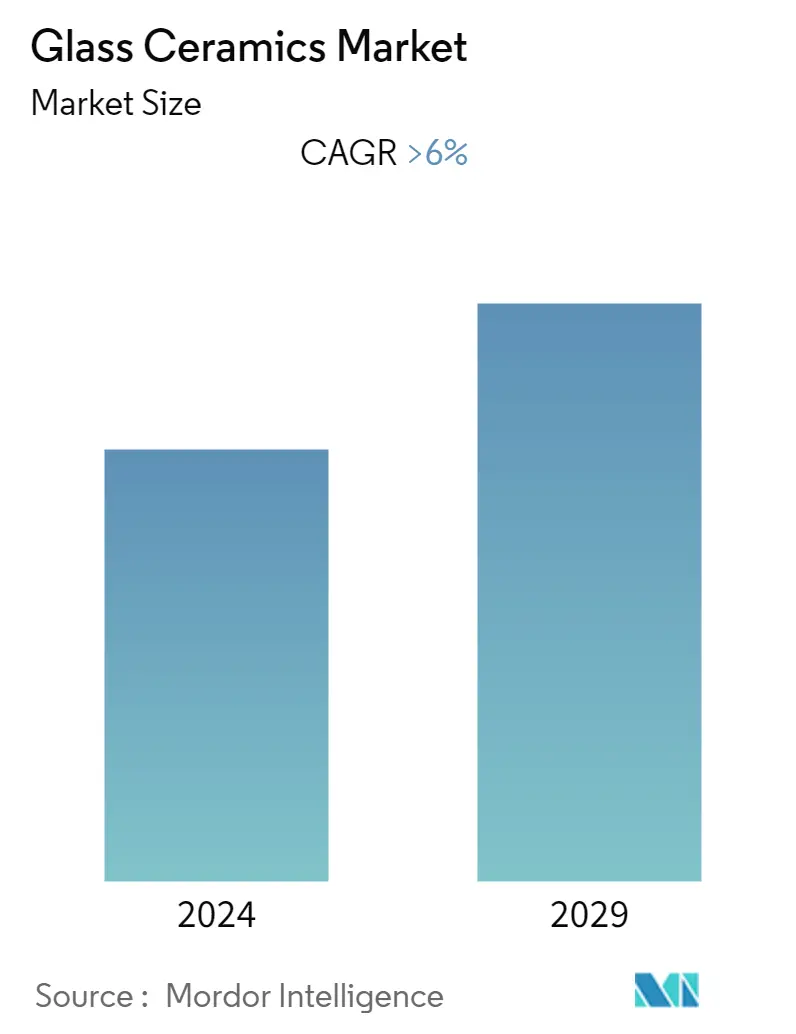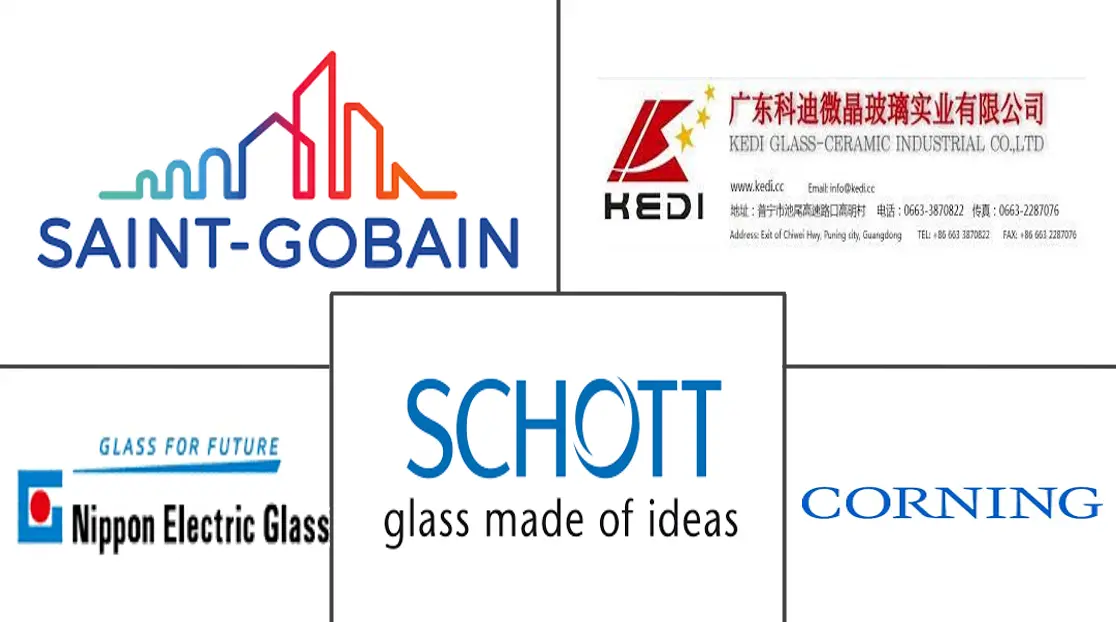Market Size of Glass Ceramics Industry

| Study Period | 2019 - 2029 |
| Base Year For Estimation | 2023 |
| CAGR | 6.00 % |
| Fastest Growing Market | Asia Pacific |
| Largest Market | Asia Pacific |
| Market Concentration | Low |
Major Players
*Disclaimer: Major Players sorted in no particular order |
Glass Ceramics Market Analysis
The market for glass ceramics is anticipated to register a CAGR of over 6% during the forecast period. Increasing demand from the building and construction sector is driving the market globally.
- The building and construction sector is expected to remain the largest application base for glass ceramics over the forecast period.
- Due to COVID-19, there was a slowdown in the building and construction industry in 2020 due to certain rules and regulations being imposed by countries. However, the industry witnessed a recovery in 2021, thus reviving the demand in the market studied.
- The increasing adoption of ceramics in electronics manufacturing processes is projected to act as an opportunity for the market in the future.
- Glass-based ceramics have a wide range of use in the aerospace industry as they are light in weight than metals and enable faster speeds and lesser fuel consumption for space vehicles. Thermal protection shield is also an application of glass ceramics in the aerospace industry. This application is considered one of the key trends in the glass ceramics market.
Glass Ceramics Industry Segmentation
Glass ceramics are composed through the crystallization of base glass. They compose properties of both glasses and ceramics. Glass ceramics possess high strength, zero porosity, translucency, and low thermal expansion, which help them achieve high thermal stability. They have an added advantage in kitchen appliances like cooktops. The glass ceramics market is segmented by material, application, and geography. By material, the market is segmented into lithium, magnesium, and zinc. By application, the market is segmented into building and construction, electrical and electronics, healthcare, aerospace, optical, and other applications. The report also covers the market size and forecasts in 15 countries across the major regions. For each segment, the market sizing and forecasts have been done on the basis of revenue (USD million).
| Material | |
| Lithium | |
| Mangnesium | |
| Zinc |
| Application | |
| Building and Construction | |
| Electrical and Electronics | |
| Healthcare | |
| Aerospace | |
| Optical | |
| Other Applications |
| Geography | |||||||
| |||||||
| |||||||
| |||||||
| |||||||
|
Glass Ceramics Market Size Summary
The glass ceramics market is poised for significant growth, driven primarily by the burgeoning demand from the building and construction sector, which remains the largest application area for these materials. Despite a temporary setback due to the COVID-19 pandemic, the industry rebounded, spurring renewed interest and demand for glass ceramics. These materials are increasingly favored in construction due to their superior properties, such as heat resistance and lightweight nature, which make them ideal for tiles and fittings. Additionally, the electronics manufacturing sector presents new opportunities for glass ceramics, further expanding their application scope. In the aerospace industry, the lightweight nature of glass ceramics offers advantages in terms of speed and fuel efficiency, with thermal protection shields being a notable application.
The Asia-Pacific region leads the global glass ceramics market, fueled by robust infrastructure development and a thriving aerospace manufacturing industry. Countries like China and India are at the forefront, with significant investments in construction and infrastructure projects driving demand. The region's dominance is supported by substantial foreign direct investment in infrastructure, particularly in India. The market is characterized by fragmentation, with key players such as Saint Gobain, Nippon Electric Glass Co. Ltd, and Corning Inc. actively expanding their operations and exploring new applications for glass ceramics. Strategic acquisitions and investments in research and development are expected to further enhance the market's growth trajectory.
Glass Ceramics Market Size - Table of Contents
-
1. MARKET DYNAMICS
-
1.1 Drivers
-
1.1.1 Growing Usage in Aerospace Applications
-
1.1.2 Increasing Demand from Building and Construction
-
-
1.2 Restraints
-
1.3 Industry Value Chain Analysis
-
1.4 Porter's Five Forces Analysis
-
1.4.1 Bargaining Power of Suppliers
-
1.4.2 Bargaining Power of Buyers/Consumers
-
1.4.3 Threat of New Entrants
-
1.4.4 Threat of Substitute Products and Services
-
1.4.5 Degree of Competition
-
-
-
2. MARKET SEGMENTATION
-
2.1 Material
-
2.1.1 Lithium
-
2.1.2 Mangnesium
-
2.1.3 Zinc
-
-
2.2 Application
-
2.2.1 Building and Construction
-
2.2.2 Electrical and Electronics
-
2.2.3 Healthcare
-
2.2.4 Aerospace
-
2.2.5 Optical
-
2.2.6 Other Applications
-
-
2.3 Geography
-
2.3.1 Asia-Pacific
-
2.3.1.1 China
-
2.3.1.2 India
-
2.3.1.3 Japan
-
2.3.1.4 South Korea
-
2.3.1.5 Rest of Asia-Pacific
-
-
2.3.2 North America
-
2.3.2.1 United States
-
2.3.2.2 Canada
-
2.3.2.3 Mexico
-
-
2.3.3 Europe
-
2.3.3.1 Germany
-
2.3.3.2 United Kingdom
-
2.3.3.3 France
-
2.3.3.4 Italy
-
2.3.3.5 Rest of Europe
-
-
2.3.4 South America
-
2.3.4.1 Brazil
-
2.3.4.2 Argentina
-
2.3.4.3 Rest of South America
-
-
2.3.5 Middle-East and Africa
-
2.3.5.1 South Africa
-
2.3.5.2 Saudi Arabia
-
2.3.5.3 Rest of Middle-East and Africa
-
-
-
Glass Ceramics Market Size FAQs
What is the current Glass Ceramics Market size?
The Glass Ceramics Market is projected to register a CAGR of greater than 6% during the forecast period (2024-2029)
Who are the key players in Glass Ceramics Market?
Saint Gobain, Nippon Electric Glass Co.,Ltd., Kedi Glass-Ceramic Industrial Co. Ltd., Corning Inc. and Schott AG are the major companies operating in the Glass Ceramics Market.

